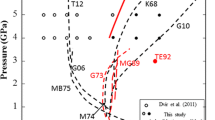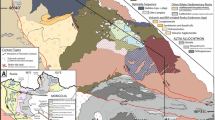Abstract
This study presents the results of dehydration melting experiments on a basaltic composition amphibolite under conditions appropriate to a hot slab geotherm (1.5 and 2.0 GPa and temperatures of 850 to 1150° C). Dehydration melting produces an omphacitic augite and garnet bearing residue coexisting with rhyolitic to andesitic composition melts. At 1.5 GPa, the amphibolite melts in two stages between 800 and 1025° C. The 2.0 GPa data also define two melting stages. At 2.0 GPa, the first stage involves nearly modal melting of the original amphibolite minerals (qtz, pl, amp) to produce melt + cpx + grt. During the second stage, the eclogite restite melts non-modally (0.86 cpx + 0.14 grt = 1 melt). The experimental results were combined with data from the literature to generate a composite P-T phase diagram for basaltic composition amphibolites over the 800 to 1100° C temperature range for pressures up to 2.0 GPa. Comparison of the major element compositions of the experimentally produced melts with compositions of presumed slab melts (adakites) shows that partial melting of amphibolite at conditions appropriate to a hot-slab geotherm produces melts similar to andesitic and dacitic adakites except for significant MgO and CaO depletions. Trace element modelling of amphibolite dehydration melting using the 2.0 GPa melting reactions produces REE abundances similar to those of adakites at 10–15 wt% batch melting, but the models do not reproduce the high Sr/Y ratios characteristic of adakites. Taken together, the major and trace element results are not consistent with the derivation of adakites by dehydration melting of the subducted slab with little or no interaction with the mantle wedge or crust. If adakites are partial melts of the subducted slab, they must undergo significant interaction with the mantle and/or crust, during which they acquire a number of their distinctive characteristics.
Similar content being viewed by others
References
Anders E, Grevesse N (1989) Abundances of the elements:meteoritic and solar. Geochim Cosmochim Acta 53:197–214
Barker F, Arth JG, Stern TW (1986) Evolution of the Coast batholith along the Skagway Traverse, Alaska and British Columbia. Am Mineral 71:632–643
Beard JS, Lofgren GE (1991) Dehydration melting and water saturated melting of basaltic and andesitic greenstones and amphibolites at 1, 3 and 6.9 kb. J Petrol 32:365–401
Defant MJ, Drummond MS (1990) Derivation of some modern arc magmas by melting of young subducted lithosphere. Nature 347:662–665
Defant MJ, Drummond MS (1993) Mount St. Helens:potential example of the partial melting of the subducted lithosphere in a volcanic arc. Geology 21:547–550
Defant MJ, Richerson PM, De Boer JZ, Stewart RH, Maury RC, Bellon H, Drummond MS, Feigenson MD, Jackson TE (1991) Dacite genesis via both slab melting and differentiation:petrogenesis of La Yeguada Volcanic Complex, Panama. J Petrol 32:1143–1167
Drummond MS, Defant MJ (1990) A model for trondhjemite-tonalite-dacite genesis and crustal growth via slab melting:Archean to modern comparisons. J Geophys Res 95:21503–21521
Dunn T, Sen C (1994) Mineral/matrix partition coefficients for orthopyroxene, plagioclase and olivine in basaltic to andesitic systems:a combined analytical and experimental study. Geochim Cosmochim Acta 58:717–733
Gilbert MC, Helz RT, Popp RK, Spear FS (1982) Experimental studies of amphibole stability. In: Veblen DR, Ribbe PH (eds) Amphiboles:petrology and experimental phase relations (Reviews in Mineralogy vol. 9B), Mineralogical Society of America, Washington DC, pp 229–346
Grove TL, Bence AE (1977) Experimental study of pyroxene-liquid interaction in quartz normative basalt. Proc Lunar Sci Conf 8:1549–1579
Haggerty SE (1990) Redox state of continental lithosphere. In: Menzies MA (ed) Continental mantle. Oxford University Press, Oxford, pp 87–102
Hofmann AW (1988) Chemical differentiation of the Earth:the relationship between mantle, continental crust, and oceanic crust. Earth Planet Sci Lett 90:297–314
Holloway JR, Pan V, Gudmundsson G (1992) High-pressure fluid absent melting experiments in the presence of graphite:oxygen fugacity, ferric/ferrous ratio and dissolved CO2. Eur J Mineral 4:105–114
Johnston AD, Wyllie PJ (1989) The system tonalite-peridotite-H2O at 30 kbar, with applications to hybridization in subduction zone magmatism. Contrib Mineral Petrol 102:257–264
Kay RW (1978) Aleutian magnesian andesites: melts from subducted Pacific oceanic crust. J Volcanol Geotherm Res 4:117–132
Kay SM, Ramos VA, Marquez M (1993) Evidence in Cerro Pampa volcanic rocks for slab melting prior to ridge-trench collision in southern South America. J Geol 101:703–714
Kress VC, Carmichael ISE (1991) The compressibility of silicate liquids containing Fe2O3 and effect of composition, temperature, oxygen fugacity and pressure on their redox states. Contrib Mineral Petrol 108:82–92
Lindsley DH (1983) Pyroxene thermormetry. Am Mineral 68:477–493
Martin H (1987) Petrogenesis of Archean trondhjemites, tonalites, and granodiorites from eastern Finland:major and trace element geochemistry. J Petrol 28:921–953
Nicholls JA, Ringwood AE (1973) Effect of water on olivine stability in theoleiites and the production of silica saturated magmas in the island-arc environment. J Geol 81:285–300
Nielsen RL, Drake MJ (1979) Pyroxene-melt equilibria. Geochim Cosmochim Acta 43:1259–1272
Peacock SM (1991) Numerical simulation of subduction zone pressure-temperature-time paths:constraints on fluid production and arc magmatism. Phil Trans R Soc London A 335:341–353
Peacock SM (1993) The importance of blueschist to eclogite dehydration reactions in subducting oceanic crust. Geol Soc Am Bull 105:684–694
Puig A, Herve E, Suarez M, Saunders AD (1984) Calc-alkaline and alkaline Miocene and calc-alkaline Recent volcanism in the southernmost Patagonian Cordillera, Chile. J Volcanol Geotherm Res 20:149–163
Rapp RP, Watson EB, Miller CF (1991) Partial melting of amphibolite/eclogite and the origin of Archean trondhjemites and tonalites. Precambrian Res 51:1–25
Rogers G, Saunders AD (1989) Magnesian andesites from Mexico, Chile and the Aleutian Islands:Implications for magmatism associated with ridge-trench collision. In:Crawford AJ (ed) Boninites and related rocks. Unwin Hyman London, pp 417–445
Rogers G, Saunders AD, Terrell DJ, Verma SP, Marriner GF (1985) Geochemistry of Holocene volcanic rocks associated with ridge subduction in Baja, California, Mexico. Nature 315:389–392
Rushmer T (1991) Partial melting of two amphibolites:contrasting experimental results under fluid-absent conditions. Contrib Mineral Petrol 107:41–59
Sajona FG, Maury RC, Bellon H, Cotten J, Defant MJ, Pubellier M (1993) Initiation of subduction and the generation of slab melts in western and eastern Mindanao, Philipines. Geology 21:1007–1010
Sekine T, Wyllie PJ (1982) The system granite-peridotite-H2O at 30 kbar, with applications to hybridization in subduction zone magmatism. Contrib Mineral Petrol 82:190–202
Sen C (1994) Subduction related petrologic processes:1 — Dehydration melting of a basaltic composition amphibolite, 2 — Mantle metasomatism. PhD Thesis, Univ New Brunswick
Sen C, Dunn T (1993) Experimental production of modally metasomatized mantle. Geol Assoc Can/Mineral Assoc Can Prog Abstr 18:A-95
Smith DR, Leeman WP (1987) Petrogenesis of Mount St. Helens dacitic magmas. J Geophys Res 92:10313–10334
Stolper EM (1982) The speciation of water in silicate melts. Geochim Cosmochim Acta 46:2609–2620
Stolper E, Holloway JR (1988) Experimental determination of the solubility of carbon dioxide in molten basalt at low pressure. Earth Planet Sci Lett 87:397–408
Wolf MB (1992) Amphibolite-tonalite relationships. Part I. Experimental investigation of the phase relationships and textural development of amphibolite dehydration-melting. Part II. The genology, petrology and geochronology of a tonalitic and mafic dike swarm (Southwestern Foothills Terrane, California). PhD Thesis, Calif Inst Tech
Author information
Authors and Affiliations
Rights and permissions
About this article
Cite this article
Sen, C., Dunn, T. Dehydration melting of a basaltic composition amphibolite at 1.5 and 2.0 GPa: implications for the origin of adakites. Contr. Mineral. and Petrol. 117, 394–409 (1994). https://doi.org/10.1007/BF00307273
Received:
Accepted:
Issue Date:
DOI: https://doi.org/10.1007/BF00307273




